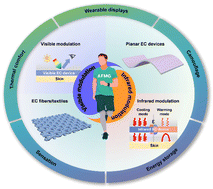Wearable electrochromic materials and devices: from visible to infrared modulation
Abstract
Wearable electronics with optical modulation in the visible and infrared range attract great interest due to promising diverse applications in displays, camouflage, visual sensation, and thermal management. Among different optical modulation approaches, electrochromic (EC) technology, with high controllability, abundant colour species, and low energy consumption, can realize reversible visible and infrared modulation through electrochemical redox reactions of the EC materials under a low voltage. As a result, the wearable flexible EC devices have made significant progress in mechanical flexibility, device structure, and optical modulation range. In this Review, we systematically introduce and discuss the recent advances in wearable EC devices with optical modulation from the visible to infrared range. The structure features for planar and fibre EC devices are first introduced. The bendable, stretchable, and EC fibre devices are then discussed based on the choice of materials and structural design. The progress of EC devices with infrared modulation is summarized according to material classification. At last, their potential applications are demonstrated in wearable displays, camouflage, energy storage, visual sensation, and thermal comfort, which may promote the wide application of wearable electronics.

- This article is part of the themed collections: Journal of Materials Chemistry C Recent Review Articles and Journal of Materials Chemistry C Emerging Investigators


 Please wait while we load your content...
Please wait while we load your content...